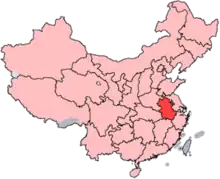Keemun
Keemun (simplified Chinese: 祁门红茶; traditional Chinese: 祁門紅茶; pinyin: qímén hóngchá; Jyutping: kei4mun4 hung4cha4; lit. 'Qimen red tea') is a famous Chinese black tea. First produced in the late 19th century, it quickly became popular in the West and is still used for a number of classic blends. It is a light tea with characteristic stone fruit and slightly smoky notes in the aroma and a gentle, malty, non-astringent taste reminiscent of unsweetened cocoa. Top varieties have orchid-like fragrance and additional floral notes in the flavor.
| Keemun | |
|---|---|
.JPG.webp) | |
| Type | Black |
| Other names | Qimen, 祁门, qímén, Qimen Hong Cha |
| Origin | Qimen County, Huangshan, Anhui, China |
| Quick description | a light black tea with floral, slightly smoky aroma and malty, unsweetened cocoa taste |
| Keemun | |||||||||||||||
|---|---|---|---|---|---|---|---|---|---|---|---|---|---|---|---|
| Traditional Chinese | 祁門紅茶 | ||||||||||||||
| Simplified Chinese | 祁门红茶 | ||||||||||||||
| Literal meaning | Qimen red tea | ||||||||||||||
| |||||||||||||||
History
 Keemun is grown in Anhui province, China |
Keemun is produced exclusively in the Qimen County in the south of Anhui province. The name of the tea is an older Western spelling of the name of the nearby town, Qimen (pronounced "Chee-men"). The tea-growing region lies between the Yellow Mountains and the Yangtze River.[1] The cultivar used for Keemun is the same as that used in production of Huangshan Maofeng. While the latter is an old, well-known variety of green tea, Keemun was first produced in 1875 using techniques adapted from Fujian province farmers.[2]
Many varieties of Keemun exist, with different production techniques used for each. Nevertheless, any Keemun undergoes particularly slow withering and oxidation processes, yielding more nuanced aroma and flavor.[1] Some of Keemun's characteristic floral notes can be attributed to a higher proportion of geraniol, compared to other black teas.[3]
Varieties

Among the many varieties of Keemun perhaps the most well-known is Keemun Mao Feng (祁門毛峰). Harvested earlier than others, and containing leafsets of two leaves and a bud, it is lighter and sweeter than other Keemun teas. Another high grade variety, containing mostly leaves and stronger than others, is the Keemun Hao Ya (祁門毫芽). For Western markets, it is separated by quality into Hao Ya A and Hao Ya B categories, the former being somewhat better than the latter. Either has a markedly intense taste.[4] Other varieties include those specifically tailored for the Gongfu tea ceremony (Keemun Gongfu, or Congou – 祁門工夫) and Keemun Xin Ya (祁門新芽), an early bud variety, said to have less bitterness. One of the black teas produced in neighboring Hubei province is sometimes referred to as a Hubei Keemun (湖北祁門) by several tea companies, but is not a Keemun in the true sense of the term.
Notes
- Harney 2008, 113.
- Huang 2000, 544.
- Linskens, Jackson 1991, 29.
- Harney 2008, 112–114.
References
- Harney, Michael. 2008. The Harney & Sons Guide to Tea. The Penguin Press, 2008. ISBN 978-1-440642036
- Huang H.T. 2000. Fermentations and Food Science, Vol. 6 of Needham, Joseph (ed.), Science and Civilization in China. Cambridge University Press, 2000. ISBN 978-0-521652704
- Linskens, Hans F., and Jackson, John F. 1991. Essential oils and waxes, Vol. 12 of Needham, Joseph (ed.), Modern Methods of Plant Analysis. Springer-Verlag, 1991. ISBN 978-0-521652704